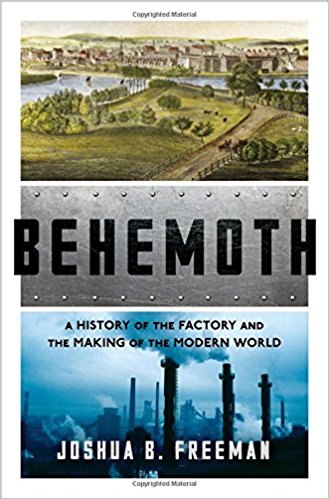You have /5 articles left.
Sign up for a free account or log in.
 Behemoth: A History of the Factory and the Making of the Modern World by Joshua B. Freeman
Behemoth: A History of the Factory and the Making of the Modern World by Joshua B. Freeman
Published in February of 2018.
Behemoth starts with an observation. We live in a manufactured world. Almost everything that we work with, wear, live in, and ride on was built in a factory somewhere.
Our buildings, and the infrastructure that makes them work, were mostly fabricated in somewhere else. Our clothing and our shoes were built in a factory. The cars we drive and ride in are factory built. So are the airplanes that we fly us, and the busses and trains we rely on for transportation.
The device that you are reading these words on was built in a factory. The phone, computer, or tablet that you are using right now was built by people working in a building (or many buildings).
And yet, this world of factories that makes modern life possible is all but invisible.
Do you know where your car was built? I bet you don’t. (I don't).
Can you actually picture the factory that your phone was manufactured? Most likely the answer is no, and this is just how Apple and Samsung and Foxconn want it.
The genius of Behemoth is that Freeman situates current role of factories in our society (indispensable but invisible) within its historical context.
Freeman begins the story of big factories at the the beginning, with the dawn of the industrial revolution and the first textile mills in England and New England. From the 18th century origins of the factory in producing cloth (first with water power, then with steam power), Freeman takes us on a tour of the origins of steel factories and automobile manufacturing.
Behemoth draws a direct line from the earliest cotton mills, and their employment of a largely child (in England) and female (in the U.S.) low-paid workforce, to the transition of factories as an engine of a middle class society.
The parts of Behemoth where I learned the most were in Freeman’s descriptions of early industrialization efforts of the Soviet Union. I had no idea that U.S. companies were so involved in working directly with the Soviet government on that nation’s pre -WWII efforts to industrialize. Learning about Soviet factory towns, and how socialist giant manufacturing differed from capitalist manufacturing, was absolutely fascinating.
Where Behemoth is particularly strong is in taking the reader inside the newest giant factories - the places where our electronics are assembled. These stupendously large Chinese electronics factories, with workforces that number in the hundreds of thousands, have emerged as areas of social concern. The suicides at Foxconn factories made many iPhone buyers wonder about our complicity in exploitative working conditions.
In Behemoth, we get a sense of how those giant Asian electronics factories actually work. They are not assembly line operations like automobiles - which we also learn a great deal about - but are rather based on countless workers assembling a series of small pieces and components into a finished product.
We also learn that as opposed to the history of integrated manufacturing, where the company both design and built the product, today’s manufacturing is unbundled. Apple designs and markets its electronics. But it does not build its phones, tablets, or computers.
The result is that where in the past companies would show off their factories (and sometimes their workers) in marketing their products, today the factory is invisible. A Foxconn factory in Shenzhen will as soon give a tour as you or I will be able to visit Jony Ive’s design studio, or the Situation Room in the White House.
This was not always the case. I remember as a kid taking a tour of the GM factory in Framingham MA, before it was permanently closed in 1989.
After reading Behemoth, I have begun to worry that my own kids (now college students) do not possess the mental scaffolding necessary to visualize where the stuff that they use is built. Pictures of factories tend to highlight industrial robots. They seldom linger on the people who work with the machines that produce the goods in which we depend.
Unless one has worked at a factory, or toured a large factory like an automobile plant, it is difficult to comprehend the scale of these building-sized machines.
Should factory tours be part of the college curriculum?
Beyond reading Behemoth, how can we give our students a better understanding of how our material culture has been built?
Do you know where your car was manufactured?
What are you reading?








